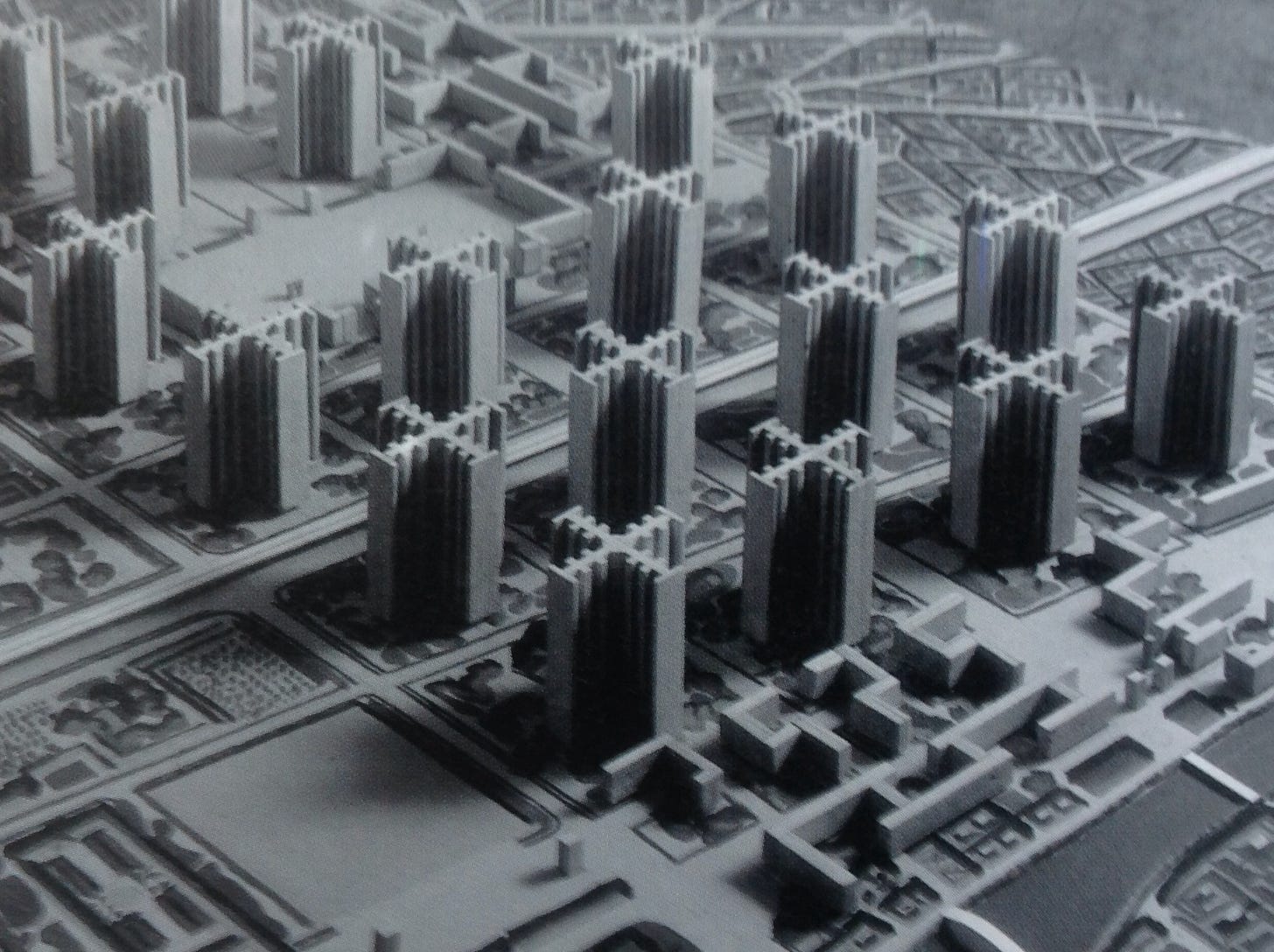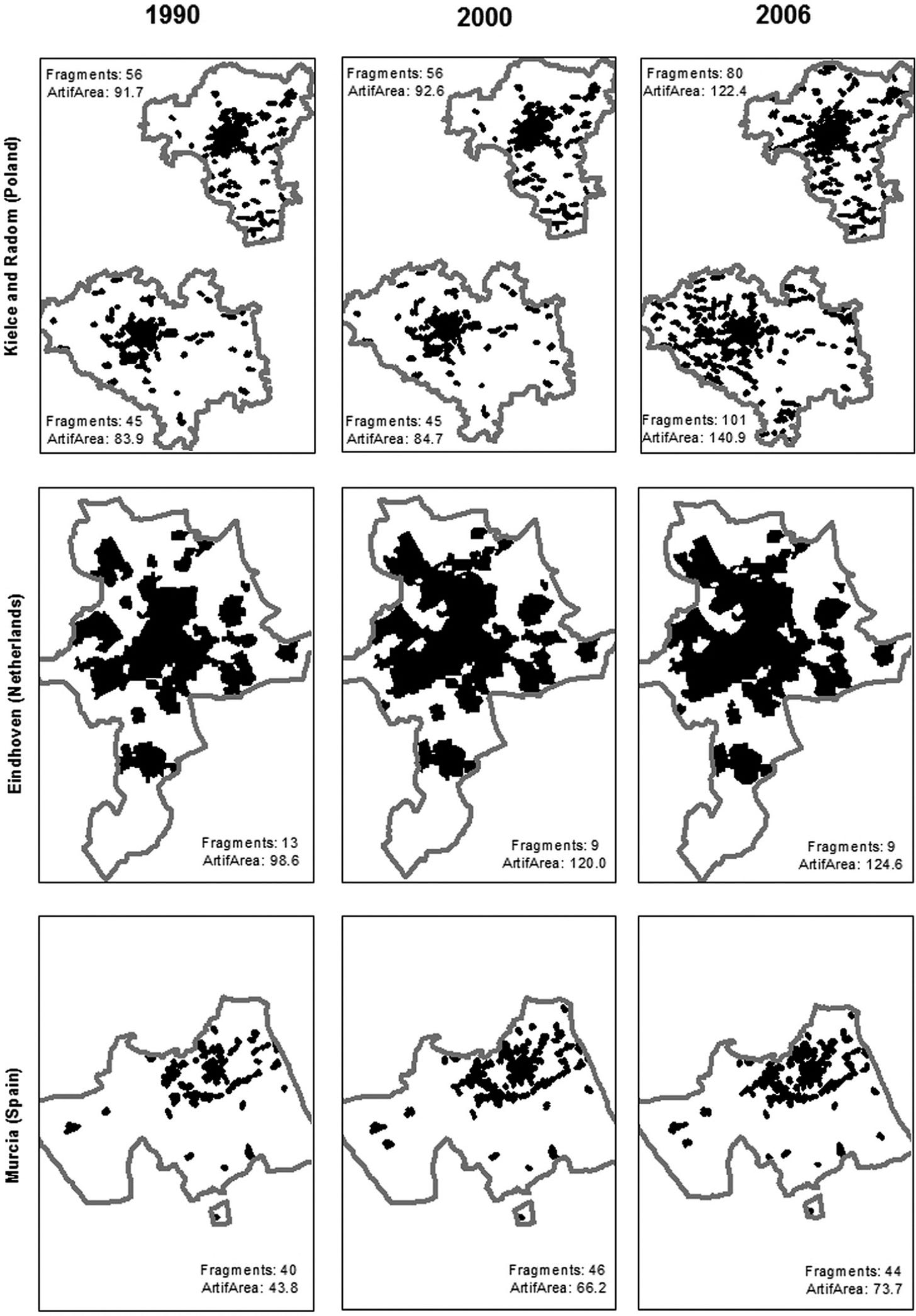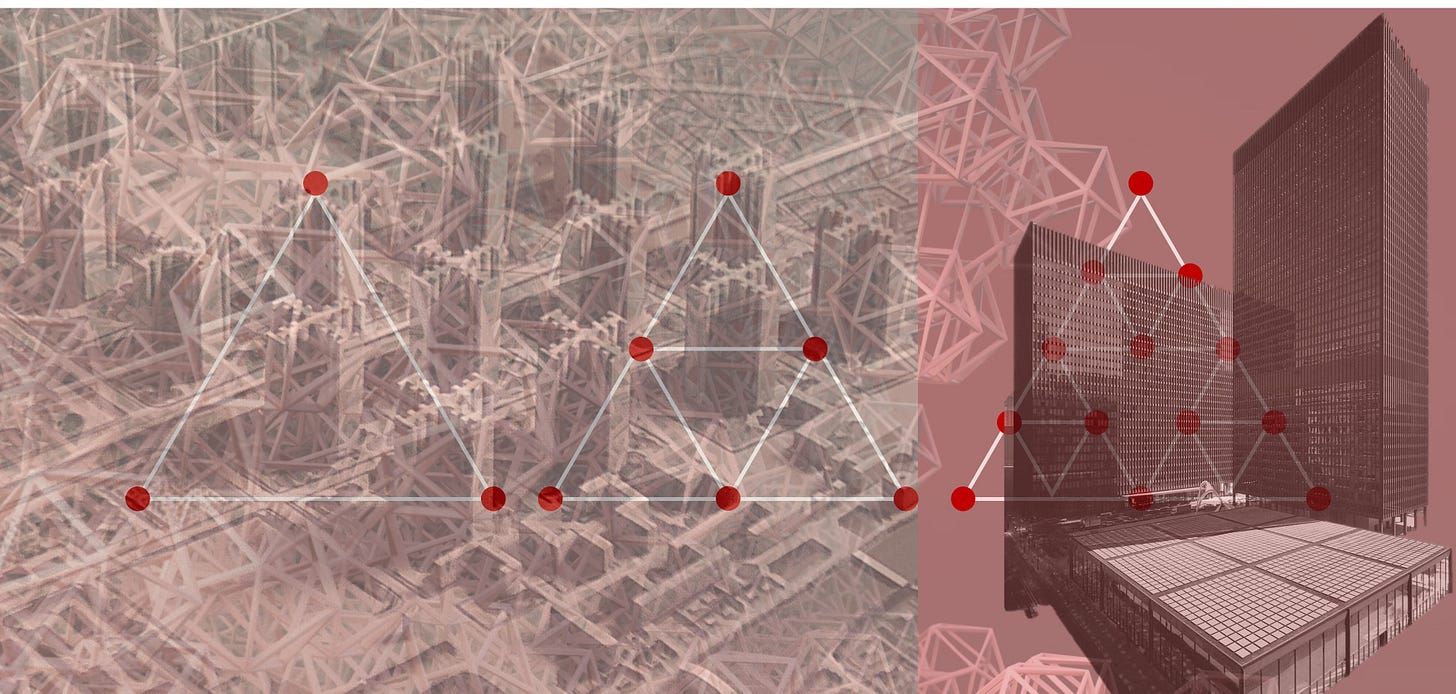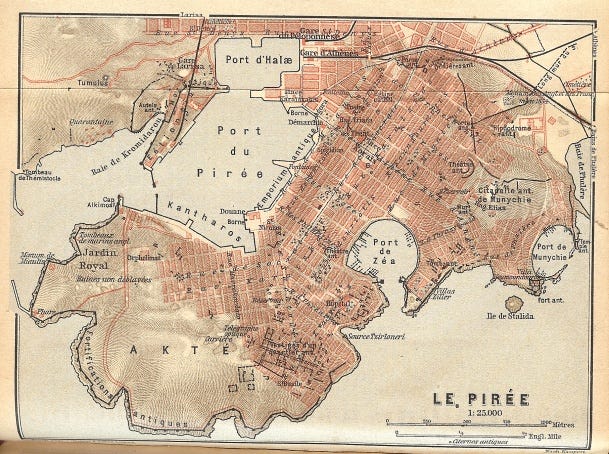Hello Interactors,
Beauty may be in eye of the beholder, but it’s also in the brain. We all seem to be drawn to balance, order, and predictable patterns which rulers, T-squares, protractors, and compasses have readily provided. It’s the stuff maps are made of. They’ve brought progress and good fortune to many over the centuries, but have they also lead to our decay?
As interactors, you’re special individuals self-selected to be a part of an evolutionary journey. You’re also members of an attentive community so I welcome your participation.
Please leave your comments below or email me directly.
Now let’s go…
HIGH FASHION
I can’t deny it. I’m a sucker for grids. I’m drawn to music, art, and designs that are balanced, orderly, and intelligible. Give me a ruler, a protractor, a compass, and a pencil and I’d happily make art and designs all day. Growing up I’d handcraft lettering on cards using my Dad’s plastic flowchart stencils. What can I say, I’m a product of modernity. A neat and tidy aesthete.
But that attraction was called into question last week as I was watching The Hobbit. The movie’s protagonist, Bilbo Baggins, lives in an organically shaped earthen home carved into the side of hill. There’s not a Cartesian grid or plane anywhere to be found. Every wall is curved as if bored into the hillside by a giant gopher. I was so smitten that I murmured out loud to my family, “I could definitely live in that house.” Has my planar proclivity passed me by, or has the curving complexity of nature caught my eye?

Neuroscience has uncovered evidence that we humans, perhaps other animals as well, tend ‘like’ and/or ‘want’ aesthetic order and balance. Evidence of elements in oddities ordered by humans abounds in centuries of found paintings, carvings, jewelry, and even cities.
But firm empirical conclusions of this gray-matter matter remain elusive. Although, neuroscientists do agree on one thing: there is no single ‘beauty center’ in our brain. When hooked up to brain imaging machines, scientists observe “activity in the frontal pole, left dorsolateral cortex, anterior cingulate cortex, temporal pole, motor cortex, parietal cortex, ventral stratum, and occipital cortex, among others.”1 And there is ongoing work trying to tease out the order in which these activities unfold betwixt the vast network of synapsis in a brain containing as many neurons as stars in the Milky Way. A task seemingly more complex than the identification of the regions themselves.
If aesthetically pleasing ordered intelligibility is indeed a universal mammalian trait, getting to that cognitive state is complex – understanding it even more so. Some scientists believe another reason concrete evidence is elusive is because the visual stimuli used across studies varies considerably.
Designing and administering cognitive research requires rationalizing inputs across studies to achieve more predictable outcomes. This ‘streamlining’ of the scientific method is not only applied to studies, but to the design and manufacturing of products, and the planning, mapping, and administration of our neighborhoods, cities, regions, and states.
Political scientist and legal anthropologist James C. Scott once alluded to the similarities between designing observational studies and the design of our modern urban environments writing,
“The builders of the modern nation-state do not merely describe, observe, and map; they strive to shape a people and landscape that will fit their techniques of observation.”2
Scott’s 1998 book, Seeing Like a State, is critical of what he calls High Modernism which is an over-reliance on Cartesian principles, the scientific method, and unfaltering faith in technology. While he admits these advances improved – and continue to improve – the human condition, he believes blind adherence to these aesthetic, bureaucratic, and technocratic principles may have also put us on a path toward what we now see as potential human extinction.
The list of ‘High Modernists’ in art, science, design, and politics is long, but Scott created a “Hall of Fame” of geo-political modernists like former U.S. Secretary of Defense and Cold War strategist Robert McNamara known for his ‘scientific management’ style, New York commissioner-cum-urban planner and power broker Robert Moses, founding head of Soviet Russia and dictator of the proletariat Vladimir Lenin, the Shah-of-Iran who sought to modernize and nationalize his entire country and industry, and the influential architect and urban designer Le Corbusier who advocated for standardized inhumane design and erasure of historical and cultural tradition – especially in the aftermath of war.

Scott’s full list includes people of not any one political persuasion. He reveals how both conservatives and progressives are capable of “sweeping, rational engineering of all aspects of social life in order to improve the human condition.” He notes they all use “unrestrained use of the power of the modern state as an instrument for achieving these designs.” And he observes the public really has no recourse, nor often the desire, to resist it. He says,
“The ideology of high modernism provides, as it were, the desire; the modern state provides the means of acting on that desire; and the incapacitated civil society provides the leveled terrain on which to build (dis)utopias.”3
That ‘desire’, as it were, I suspect is partially driven by the aesthetics found in the uniformity, balance, and order of ‘High Modernists.’ Parsimony, the reductive removal of redundancy, is what persuades people to purchase overpriced but simplified products like Prada. It’s what spurred Tom Wolfe to observe in his book From Bauhaus to Our House that elite modernists want to fill cities with “row after row of Mies van der Rohe.” The German architect was known for his stark rectilinear buildings made of what he called ‘skin and bone.’

In addition to fashion and architecture, modernist desire was (and still is) embodied in many elements of society and popular culture from literature, to industry, to transportation. Much of this progress occurred during the Industrial Age of the 19th century. I can imagine the exhilaration of high speed movement through space over time on a bike, car, or train surely began with fright but ended in delight. Even desirable.
As Scott points out, the state provided the means for this desire to manifest. He invites us to,
“imagine that what these designers of society had in mind was roughly what designers of locomotives had in mind with ‘streamlining.’ Rather than arresting social change, they hoped to design a shape to social life that would minimize the friction of progress. The difficulty with this resolution is that state social engineering was inherently authoritarian.”4
FROM CRAWLING TO SPRAWLING
It was locomotives that brought many colonizers to my home town, Norwalk, Iowa in the late 1800s. But the first was Samuel Snyder in 1852. He built a log cabin near an area called Pyra. He was likely on the land of the Báxoje (Bah-Kho-Je) people, or as neighboring tribes called them ayuhwa “sleepy ones” otherwise known as Iowa. Pyra was a few miles south of the state capital, Des Moines (Hartford of the West) that was incorporated just one year earlier.
By 1856, four years later, Pyra had a post office and a new resident, George Swan, who made his presence known by “putting up a pretentious edifice, to be used as a hotel.”5 Swan was a politician and newspaper publisher who moved from Norwalk, Ohio but was born in Norwalk, Connecticut. He became postmaster in part to change the name of the town from Pyra to Norwalk.

The renaming of Indigenous place names to Western names is another common act of the ‘High Modernist’, as is laying out a town in your vision. Which was the next thing Swan did.
The county and the township had already been gridded and platted as part of Thomas Jefferson’s squaring of a nation, but it was Swan’s ‘authoritarian’ vision that allowed for the ‘social engineering’ of the town I grew up in. He was aided by a handful of settlers including Jesse Huff and Mary Huff. One of my best friends came from the Huff family, his uncle was our baseball coach, and his grandpa was the long time Norwalk city manager. That’s three generations of city administration aided by the modern state’s ‘means of acting on the desire’ to ‘level terrain’ so they may build their ‘utopia.’
It took until the 1950s and 60s before Norwalk become a true suburb of Des Moines – an expansion beyond what Swan could ever have imagined. Its population sputtered growing modestly between 1900 and 1950 from 287 to 435, but then grew 205% between 1950 and 1960 to 1,328. The town didn’t expand beyond Swan’s initial footprint until 1969 and it’s been sprawling ever since. It’s now hard to discern the border between Des Moines and Norwalk. When I lived there in the 60s, 70s, and 80s corn and soybean fields provided a visible gap.
Despite these well-intentioned ‘High Modernists’ sprawling attempts around the world at carefully planned and engineered social utopias, scholarly literature reveals what Scott suspects. Research across economists, geographers, and planners suggests this general consensus:
“urban sprawl as a multidimensional phenomenon [is] typified by an unplanned and uneven pattern of urban development that is driven by a multitude of processes and which leads to the inefficient utilisation of land resources. Urban sprawl is observed globally, though its characteristics and impacts vary.”6
The words ‘uneven’ and ‘multitude of processes’ and ‘inefficient utilization’ resulting in ‘varying impacts’ don’t fit the exacting premise promised by enlightened ‘High Modernists.’ This study I’m quoting was done in reaction to the fact that despite the populations of European cities declining, their footprints have continued to sprawl since the 1970s. They say, “There is no sign that this trend is slowing down and, as a result, the demand for land around cities is becoming a critical issue in many areas.” This is the essence of urban sprawl.

The ordinal origins of sprawl are synonymous with their historic modernist and economic origins – the Central Business District. The shape and pattern of the impending sprawl in the United States and Europe is like a spider spinning it’s web from the center out. Causes are often oversimplified by a focus on the economic trade-off between housing prices and commuting costs. Importantly, this economic function is a result of the modern state’s role in ‘providing the means of acting on the desire’ of select individuals to live ‘elsewhere.’
There are other factors that determine the shape, resolution, and scale of sprawl. A 2006 study determined that
“sprawl in the USA between 1976 and 1992 was positively related to groundwater availability, temperate climate, rugged terrain, decentralised employment, early public transport infrastructure, uncertainty about metropolitan growth and the low impact of public service financing on local taxpayers.”7
Other studies include another big factor in the United States, ethnicity: that same 2006 study found “that increases in the percentage of ethnic minority populations within cities and rising city centre crime rates both led to a growth in urban sprawl.” Curiously, a similar study focused on Europe “confirmed the positive impact of higher crime rates on sprawl, but observed the opposite effect for the impact of ethnic minority populations.”8
I HAVE A CITY IN MIND
Sprawl isn’t just happening in the U.S. and Europe, but in developing countries as well. Since opening up in 1979, China has seen unprecedented sprawl in conjunction with their rise in socioeconomic development. Urbanization increased “17.92% in 1978 to 59.60% in 2018, and scholars predict it will reach 70% in 2035 and 75% in 2050.”9

As is the case in the United States and Europe, “the expansion of urban land mainly sacrifices rural land, especially cropland, which produces negative effects such as ecological degradation, water and land loss, and soil pollution.” This study concludes that “urban land expansion has garnered much attention, and studies have focused on land transition monitoring, effects analysis, and mechanism identification. However, discussions on suburban development and its subsequent effects remain insufficient.”
These researchers draw attention to three commonly used dimensions in studying sprawl:
Administrative - Administrative boundaries such as towns close to a city.
Spatial - Location, Density, and Spatial Activity adjacent and within commuting distance of the city.
Social - Attributes such as classes, races, and ethnicities of residents that distinguish cities and suburbs.
A primary thrust of ‘High Modernism’ are found in those first two dimensions. ‘High Modernists’ seek to ease the ‘administrative’ costs through the reduction of ‘spatial’ complexity. There’s actually nothing modern about that, really. Unless you consider the 5th century BC Greek polymath Hippodamus ‘modern’. He is considered the ‘father of European urban planning’ beginning with his grid plan of the Greek port city Piraeus that remains today. But being a mathematician, he no doubt was seeking spatial parsimony for city administrators.
The economist Herbert Simon (who studied decision making in large organizations) describes the ‘administrative man’ this way:
“Administrative man recognizes that the world he perceives is a drastically simplified model of the buzzing, blooming confusion that constitutes the real world. He is content with the gross simplification because he believes that the real world is mostly empty – that most of the facts of the real world have no great relevance to any particular situation he is facing and that most significant chains of causes and consequences are short and simple.”10
Simon elucidates how the first two dimensions of the effects of ‘High Modernist’ urban sprawl, – ‘administrative boundaries’ and remote measures of ‘spatiality’ – are ‘gross simplifications’ of the ‘buzzing, blooming confusion that constitutes the real world.’ This ‘real world’ may be better evidenced in the third dimension of measures, ‘social attributes such as classes, races, and ethnicities of residents that distinguish cities and suburbs.’
But even these attributes can remain removed the real world if viewed from a map or table of data. We need only look at Redlining as an example of how ‘social’ dimensions can be used to negate, subjugate, frustrate, dictate, alienate, arbitrate, automate, and attempt to eliminate certain classes, races, and ethnicities through actuated, calculated tax rates, interest rates, and loan rates through a slate of mandates from magistrates of the city-state, state-state, and nation-state.
The French Philosopher, Michel de Certeau, observes in his book The Practice of Everyday Life how Walking in the City, despite its gridded plans, results in people defiantly deploying practical and tactical shortcuts despite attempts by centuries of ‘High Modernism’ to control them. He writes that ‘the City’,
“provides a way of conceiving and constructing space on the basis of a finite number of stable, isolatable, and interconnected properties.”
But he also wonders if this concept of the city is decaying. He reflects on the strength, resiliency, and tenacity of humanity despite the potential erosion of ‘High Modernism’ and asks,
“Does that mean that the illness afflicting both the rationality that founded it and its professionals afflicts the urban populations as well?”
He invites us to not turn our “bewilderment” of ‘High Modernism’ in ‘catastrophes’” of its undoing but instead,
“analyse the microbe-like, singular and plural practices which an urbanistic system was supposed to administer or suppress, but which have outlived its decay…”
As much as I like the ordered, gridded aesthetic, I’ve come to better appreciate the beauty in our ‘microbe-like’ natural world. Modernity may be defined by the analytical geometry of Descartes, but I can’t help but wonder if the work of another 17th century mathematician may come to shape our future.
His name is Gottfried Wilhelm Leibniz, the German mathematician who invented, perhaps along with Isaac Newton, calculus. Leibniz is also credited with discovering self-similarity which forms the bases for Benoit Mandelbrot’s fractals. Mandelbrot’s geometry, his ‘Art of Roughness’, describes the mathematics behind branching systems found in fern leaves, cauliflower, trees, and coastlines as well as our circulatory system, nervous system, bronchial system, and maybe even Bilbo Baggin’s hobbit home in the hill.
If it wasn’t for the fractal-like nature of the gray-matter of our brain, it wouldn’t be able fold upon itself to fit within the small cavity of our cranium. Even its network of neurons, and the synaptic patterns they form as we fawn over beauty, follow the mathematical laws of Leibniz and Mandelbrot. Our world may not need be ordained by Cartesian order because it’s already organized. We just need to understand it and follow its lead.

As neuroscientists continue to map the brain in search of what draws us to order and balance in objects as well as cities, perhaps they could consider the conjecture of British physicist and distinguished professor of the Santa Fe Institute, Geoffrey West when he writes:
“…because the geometry of white and gray matter in our brains, which forms the neural circuitry responsible for all of our cognitive functions, is itself a fractal-like hierarchical network, this suggests that the hidden fractal nature of social networks is actually a representation of the physical structure of our brains. This speculation can be taken one step further by invoking the idea that the structure and organization of cities are determined by the structure and dynamics of social networks…
…In a nutshell: cities are a representation of how people interact with one another and this is encoded in our neural networks and therefore in the structure and organization of our brains.”
Brain, Beauty, and Art: Essays Bringing Neuroaesthetics into Focus. Edited by Anjan Chatterjee, Eileen Cardilo. Oxford University Press. 2021.
Seeing Like a State: How Certain Schemes to Improve the Human Condition Have Failed. Yale University Press. James C. Scott. 1998.
Ibid.
Ibid.
The History of Warren County, Iowa: Containing a History of the County, Its Cities, Towns, &c, Volume 1. Higginson Book Company. 1879. p. 502.
Determinants of urban sprawl in European cities. Determinants of urban sprawl in European cities. Walid Oueslati, Seraphim Alvanides, Guy Garrod. Journal of Urban Studies. 2015.
Ibid.
Ibid.
Mapping Suburbs Based on Spatial Interactions and Effect Analysis on Ecological Landscape Change: A Case Study of Jiangsu Province from 1998 to 2018, Eastern China. Urban and Rural Planning, School of Architecture, Soochow University. Yasi Tian. 2020.
(2)













